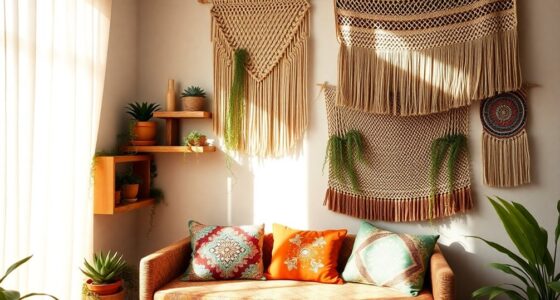To start with biophilic design, bring in some greenery like houseplants or vertical gardens to improve air and create visual interest. Maximize natural light through well-placed windows and skylights to brighten your space. Incorporate natural materials like wood, stone, or textured textiles for warmth. Use calming earth tones and nature-inspired patterns to connect indoors with outdoors. You can also add water features for tranquility and enhance views of nature from inside. Keep exploring to discover more simple ways to make your space feel more natural.
Key Takeaways
- Incorporate potted plants and vertical gardens to quickly introduce greenery indoors.
- Maximize natural light by adjusting window placement and using skylights or glass doors.
- Choose natural materials like wood, stone, and textured textiles for immediate warmth and authenticity.
- Use calming earth tones and nature-inspired patterns in color schemes and decor.
- Add simple water features such as tabletop fountains to foster serenity and tranquility.
Bring Nature Indoors With Greenery

Bringing nature indoors with greenery is one of the simplest ways to incorporate biophilic design into your space. Adding plants improves indoor air quality by filtering toxins and increasing oxygen levels, creating a healthier environment. Choose a variety of plants to boost air purification and add visual interest. Additionally, incorporating greenery can support wildlife habitats by providing shelter and food for small creatures like insects or birds if you have outdoor access. Even in urban settings, you can create mini habitats with potted plants or vertical gardens. Not only do these green elements enhance your space’s aesthetic, but they also promote well-being and a connection to nature, making your environment more vibrant and lively.
Maximize Natural Light in Your Space

Maximizing natural light in your space can substantially enhance its ambiance and your well-being. To achieve this, consider strategic window placement to allow maximum sunlight entry throughout the day. Skylight installation is another effective method, bringing in sunlight from above and brightening even shaded areas. Think about positioning windows near seating areas or workspaces to optimize daylight. Avoid blocking windows with large furniture or heavy drapes. Use glass doors or transom windows to expand light flow. Here’s a quick visualization:
| Window Placement | Skylight Installation |
|---|---|
| Place windows facing the sun’s path | Install skylights on the roof for overhead light |
| Use large, unobstructed windows | Position skylights over darker rooms |
| Keep window treatments minimal | Ensure skylights are well-sealed to prevent leaks |
Additionally, choosing energy-efficient window styles can help regulate indoor temperatures while maximizing natural light.
Incorporate Natural Materials and Textures

You can enhance your space by choosing sustainable materials that are both eco-friendly and visually appealing. Incorporating textured surfaces adds depth and invites touch, making your environment more engaging. Mixing natural finishes creates a warm, authentic vibe that connects you to nature effortlessly. Additionally, selecting materials with high nutrient density can contribute to a healthier indoor environment by improving air quality and comfort.
Select Sustainable Materials
Selecting sustainable materials is essential for creating biophilic spaces that foster a healthy connection with nature. Using recycled plastics in furniture or decor reduces waste and minimizes environmental harm, making your space more eco-friendly. Bamboo flooring is another excellent choice; it’s a fast-growing, renewable resource that adds warmth and a natural feel to your environment. When choosing materials, prioritize those with low environmental impact, such as reclaimed wood or biodegradable options. These choices not only support sustainability but also enhance the organic aesthetic of your space. Incorporating digital literacy programs can also encourage playful and meaningful communication with nature-inspired themes. By selecting materials thoughtfully, you create a healthier, more harmonious environment that aligns with biophilic principles and encourages a deeper connection to nature.
Integrate Textured Surfaces
Incorporating natural materials and textures into your space enhances its tactile richness and deepens the connection to nature. To achieve this, focus on creating texture contrast by combining rough, smooth, and organic surfaces. Use wooden beams alongside stone accents or woven textiles with sleek ceramics to add visual and tactile variety. Tactile layering invites you to explore different feels under your fingertips, making the environment more engaging. Incorporate materials like cork, rattan, or clay to introduce authentic textures that evoke nature’s essence. These natural surfaces not only enhance aesthetic appeal but also foster a sense of calm and groundedness. Understanding the importance of sensory engagement can further deepen your connection to natural environments. By intentionally integrating textured surfaces, you make your space more inviting, lively, and aligned with the principles of biophilic design.
Mix Natural Finishes
Blending natural finishes creates a layered, authentic environment that amplifies the principles of biophilic design. Incorporate a mix of textures and materials to bring warmth and character to your space. Here are four ways to do it:
- Use wood accents, like furniture or beams, to add warmth and visual interest.
- Incorporate stone finishes, such as accent walls or flooring, for earthy texture.
- Combine smooth and rough surfaces to create contrast and depth.
- Layer different natural materials, like woven textiles with wood and stone, for a rich tactile experience. Additionally, utilizing recycled products for planters and decor can enhance sustainability and authenticity in your design.
Use Nature-Inspired Colors and Patterns

Using earth tones and hues can instantly create a calming, natural atmosphere in your space. Incorporating natural patterns, like leaf or bark designs, adds visual interest rooted in nature. Botanical color palettes bring freshness and vibrancy, making your environment feel more connected to the outdoors. Additionally, integrating best anime movies or animated films that touch hearts can inspire a creative and emotionally resonant ambiance in your design.
Earth Tones and Hues
Earth tones and hues draw their inspiration directly from nature, creating a calming and grounded atmosphere in design spaces. These colors echo the earthy soil textures and mineral pigments found in nature, making your environment feel more organic and soothing. To incorporate them effectively, consider these steps:
- Use warm browns and muted greens that resemble soil and foliage.
- Select paint shades inspired by mineral pigments, like ochre and terracotta.
- Mix textures that mimic soil textures for furniture or decor elements.
- Pair earth tones with natural materials like wood and stone to enhance authenticity.
Natural Pattern Integration
Incorporating natural patterns into your space brings the organic beauty of the outdoors inside, creating a harmonious environment. Use pattern repetition with organic shapes like flowing lines and curves to evoke nature’s rhythm. Repeating these patterns across textiles, wallpapers, or décor reinforces a sense of cohesion and calm. When selecting patterns, focus on designs inspired by leaves, waves, or stones to enhance the natural feel. To visualize this, consider the table below:
| Pattern Type | Example | Effect |
|---|---|---|
| Repetitive motifs | Leaf prints | Creates consistency |
| Organic shapes | Flowing curves | Mimics natural movement |
| Natural textures | Bark, stone | Adds tactile interest |
| Subtle patterns | Water ripples | Evokes tranquility |
Additionally, utilizing visualization techniques can help you better imagine how these patterns will complement your space and promote a sense of well-being.
Botanical Color Palettes
Botanical color palettes draw inspiration directly from nature’s vibrant and calming hues, helping you create spaces that feel both lively and serene. These palettes use natural pigment inspiration to evoke the essence of plants, flowers, and landscapes. To incorporate botanical colors effectively, consider these ideas:
- Use earthy greens and muted browns to connect spaces with forest and soil tones.
- Incorporate soft pinks and lavender inspired by blooming flowers for a gentle touch.
- Add vibrant yellows and oranges that mimic sunlit blossoms for energy.
- Combine cool blues and teals reflecting water and sky for tranquility.
- Explore top beach towns on the East Coast for additional inspiration on natural landscapes and scenery that can influence your color choices.
Integrate Water Elements for Calmness

Adding water features to your space can substantially enhance feelings of calmness and tranquility. Incorporating water elements like fountains, small ponds, or tabletop waterfalls introduces soothing aquatic sounds that promote relaxation. The gentle flow of water creates a peaceful atmosphere, helping you unwind and reduce stress. You don’t need elaborate setups; even simple water features can make a noticeable difference. As you listen to the calming aquatic sounds, your mind naturally relaxes, and your environment feels more inviting. Placing water elements near seating areas or workspaces invites mindfulness and focus. Remember, the goal is to evoke serenity, so choose water features that produce gentle, continuous sounds and complement your overall biophilic design. Water elements can also help improve indoor air quality and humidity levels, contributing to a healthier environment.
Create Views of the Outdoors From Inside

Creating clear views of the outdoors from inside your space brings nature directly to your daily experience, enhancing your sense of connection and well-being. To maximize this, consider these key steps:
- Optimal window placement: Position windows where they offer the best outdoor views without obstructions.
- Large, unobstructed windows: Use expansive glass to bring in more natural light and scenic views.
- Strategic height: Place windows at eye level for immersive outdoor scenes.
- Frame outdoor views: Use window treatments or landscaping to highlight specific nature scenes.
Focusing on window placement and outdoor views helps you create a seamless indoor-outdoor connection, making your space feel more inviting and alive with nature. Biophilic design principles emphasize the importance of these features in promoting well-being and comfort.
Frequently Asked Questions
How Does Biophilic Design Improve Mental Health?
You can boost your mental health by increasing your nature connection, which helps reduce stress. When you surround yourself with natural elements like plants, sunlight, or views of greenery, your mind feels calmer and more relaxed. This connection to nature promotes feelings of tranquility and improves overall well-being. Incorporating these simple natural touches into your environment can make a meaningful difference in managing stress and enhancing your mental health.
Can Small Spaces Benefit From Biophilic Design?
Yes, small spaces can definitely benefit from biophilic design. By focusing on space optimization, you can incorporate natural elements like plants, natural light, and organic textures without cluttering. These additions boost aesthetic enhancement and create a calming environment. Even in limited areas, thoughtful placement of greenery or natural materials makes the space feel larger, more inviting, and better connected to nature, improving your overall well-being.
What Budget Options Exist for Implementing Biophilic Elements?
Imagine planting a small garden; you don’t need a vast space or expensive tools. Similarly, you can incorporate biophilic elements using cost-effective options and budget-friendly materials like indoor plants, natural fabrics, or DIY green walls. These simple steps create a calming environment without breaking the bank. Think creatively—repurpose materials and focus on quality over quantity—to bring nature inside without overspending.
Are There Any Plants That Are Better for Indoor Air Quality?
When choosing air purifying plants for your space, you’ll want options that improve air quality and are easy to care for. Plants like snake plants, pothos, and peace lilies are excellent choices, offering low maintenance greenery while actively filtering toxins. These air purifying plants boost indoor air quality without demanding much attention, making them perfect for adding natural beauty and health benefits to your environment effortlessly.
How Can Biophilic Design Be Adapted for Offices?
To adapt biophilic design for offices, focus on nature integration by adding plenty of plants, natural light, and organic materials. Incorporate ergonomic furnishings that promote comfort and wellbeing, making the workspace more inviting. Use natural textures and colors that mimic outdoor environments. These steps help create a calming, productive atmosphere, blending nature seamlessly into your office while supporting employee health and satisfaction.
Conclusion
By bringing greenery inside, maximizing natural light, and incorporating natural textures, you create a calming, inviting space that reconnects you with nature. Did you know that just having plants indoors can boost your mood and productivity by up to 15%? So, start small—add a plant or two, open those curtains, and enjoy the soothing benefits of biophilic design. These simple steps make your space healthier, happier, and more inspiring every day.









